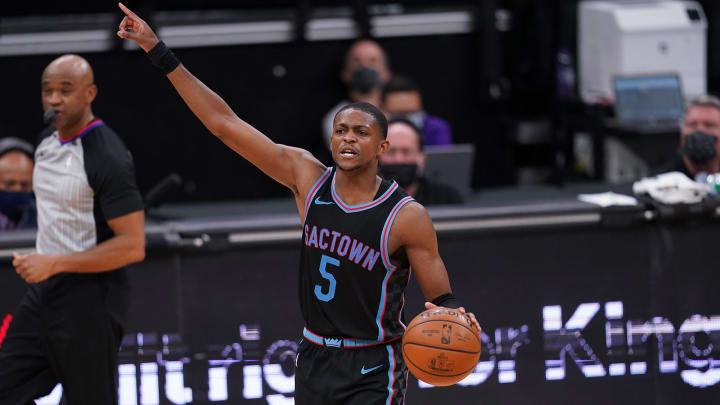De’Aaron Fox Deserves Our Attention

On January 24th, the Sacramento Kings were 6–10, with three wins in their previous dozen games. FiveThirtyEight gave them a 2% chance to make the playoffs, and any belief in a bounce back toward competitive, non-joke basketball felt unthinkable for a variety of reasons, including every embarrassing step toward futility that the organization made over the past 15 years.
Of course, the Kings then won eight of their next nine games, beating the Knicks, Celtics, Nuggets, Raptors, Pelicans, and Clippers—their only loss was by one point in Miami. Over the past two weeks, Sacramento’s historically pitiful defense has quietly settled in around league average. They deploy a five-man unit—featuring rookie sensation Tyrese Haliburton and Harrison Barnes (who’s looked like an All-Star) at the four—that has the second-highest net rating in the league among all groups that have logged at least 100 minutes.
Just like that, the Kings are no longer a laughingstock—if the season ended today they’d have a seat at the play-in table—and De’Aaron Fox stands out as the most important reason why.
In the same week he called out the NBA’s pandemic All-Star plan, Fox looked plenty deserving of an invite. Since Sacramento started to win, he’s averaged 27 points, eight assists, and four rebounds per game. (Fox’s 10 points per fourth quarter ranks third behind Bradley Beal and Zach LaVine.)
Also important: The subtle rearrangement in Fox’s shot selection. Last year, he made 29.2% of his threes. Instead of backing away from the arc, an area of the court that’s never been his close friend, Fox has incorporated it over the past few weeks more dramatically than ever before.
Heading into this season, Fox’s longest streak attempting at least five threes in a game was two in a row. Today, he’s at eight straight. (Put another way, he’s launched at least seven threes 15 times in his career. Nine of those games have been this season.)
The most fascinating bump has come in spots where he creates the chance for himself. Right now, 20.4% of all of Fox’s shots have been pull-up threes, a massive increase from the past three years, when his frequency lingered between 10–13%.
This doesn’t mean he’s Damian Lillard—only 32.1% have gone in and he still favors the mid-range—but Fox’s volume on a shot that’s powerful enough to lift him from “exciting speed demon” to “perennial All-Star/annual All-NBA candidate” has essentially gone from Ja Morant to Chris Paul. And in the last eight games, he’s averaging five pull-up threes and making 38.5% of them. This development deserves serious attention. Watch Fox and it’s clear his mentality has changed. He’s rising up with confidence, be it in a crowd . . .
. . . or as a more common way to punish defenders who duck under a ball screen.
Fox isn’t just taking what the defense gives. He’s aggressive, utilizing more side-steps, stepbacks, and escape dribbles to create space if a driving lane isn’t there or he doesn’t want to settle for a long two.
Fox is taking fewer shots at the rim, but he’s making an ungodly 70% once he gets there—placing him in the 100th percentile among point guards, according to Cleaning the Glass. At least some—not all—of this is due to opponents needing to second guess how hard they want to close out when he catches a pass.
On nearly two attempts per game, Fox has drilled 45.7% of his spot-up threes this season. Some defenders still stop short, which is understandable since Fox’s first step could light a match. But at the same time, uncontested threes are a strategic faux pas. And defenders who have to decide whether they want to leave Fox open or run him off the line are quickly realizing the impossible predicament they’re in.
It’s not that Fox was an accelerator-pressing novelty act before he started taking more threes, or that his relative meekness behind the line held the rest of his game hostage. But this was previously the closest thing his game had to a fatal flaw; if his abrupt willingness to pull up at a moment’s notice holds, he’s infinitely more difficult to deal with. It’s a small sample size, but if Fox continues to knock down enough of these shots, it’ll completely tilt how opponents guard him—they still duck under screens like he’s Derrick Rose or Ricky Rubio—and that’s how the 23-year-old can reach another level.
There are several reasons why Sacramento saved its season a few weeks ago. Fox’s recent embrace of the three-point line is as meaningful as any of them.
